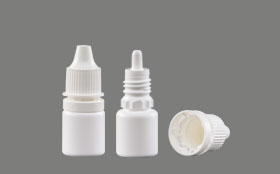The microbial limit inspection method is a method to inspect the degree of microbial contamination of non-specified sterilized preparations and their raw materials and auxiliary materials. The inspection items include the number of bacteria, molds, yeasts and control bacteria. At present, most pharmaceutical packaging has specific regulations on microbial limits, and eye drop bottles used as eye medications are no exception. So, how to detect the microbial limit of the eye drop bottle? How is it required in relevant industry standards?
The eye drop bottle consists of a bottle body, an inner stopper and a bottle cap. The specification is generally 5ml-100ml, and the material is mostly low-density polyethylene.
According to the relevant standards of "YBB20072012 Low Density Polyethylene Medical Eye Drop Bottles", the microbial limit detection follows the following methods and standards: Take several test bottles, add 1/2 nominal volume of sodium chloride injection, and tighten the cap , Shake for 1 minute to get the test solution. The test solution shall be tested in accordance with the law after membrane filtration (Chinese Pharmacopoeia 2010 Edition Two Appendix XIJ). Bacteria must not exceed 100cfu per bottle, molds and yeasts must not be detected, Staphylococcus aureus must not be detected, and Pseudomonas aeruginosa must not be detected. Check out.
Whether the microbial limit meets the standard is related to the quality of the eye drop bottle. If the unqualified product is used in the medicine, it will not only pollute the medicine, but also seriously affect the health of the patient. The importance of pharmaceutical packaging cannot be ignored, and pharmaceutical packaging material manufacturers should strictly control the quality to protect the safety of drugs.

没有评论:
发表评论